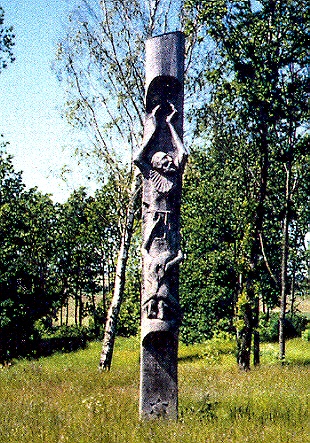 >>>>>
>>>>>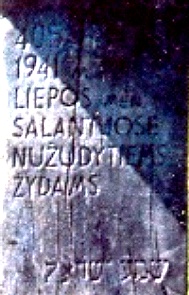
 >>>>>
>>>>>
Below are the descriptions of the old Jewish cemetery of Salant by Mr. Irwin Sagenkahn who visited it in 1993 and 1996:
June 1993 Following the dirt path which some sort of vehicle had made we continued through the field. for about 100 yards to where a fairly new granite monument had been erected. And there it was, the old Jewish cemetery at Salantai
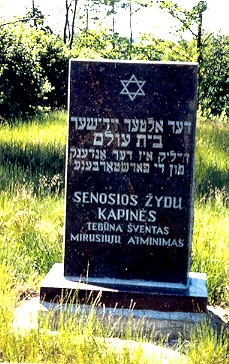 >>>>>
>>>>>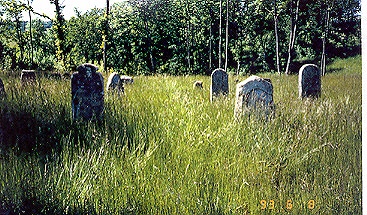
These monuments to our right, a portion of the old cemetery wall remained. There were a number of monuments, maybe 30 in all, six wide and five deep, standing like soldiers in formation. Some of the monuments looked like large pieces of fieldstone with no markings at all. That area was at the top of what might be described as a rolling hill. As I looked at the meadow beyond, it looked just like the meadow in the picture I had of my paternal grandfather's monument (Shmuel Sagenkahn) taken some 70 years earlier.
Of the 30 odd monuments erected in this fashion, not more than six had inscriptions which were halfway legible. I sprayed some shaving cream I had with me to highlight the inscription on one of the monuments and took a picture of it. Egle, (the Lithuanian guide) in the meantime, explored another area 50 to 100 yards down a slight incline and told us she found more tombstones. ~ I had given her the picture of my grandfather's stone which had a wreath at the top. We were all look1ng for a stone with that type of wreath at the top. We were walking through weeds which were knee high and which had heavy shrubbery growth. I suspect the orderly arrangement of the tombstones at the front of the cemetery had been put there within the past few years. I assume those stones were unearthed in the gully area where we found some other monuments. These were sort of scattered in a haphazard arrangement. I am only guessing, but it would appear to me the cemetery was at one time
desecrated and the stones were all thrown in the gully area where Egle had located some of the monuments. Maybe some of were then arranged at the front of .the cemetery for the dedication of the new memorial.
Egle had called to us that she had found a stone with the same type of wreath at the top. Unfortunately, it was not my grandfather's stone. But I sprayed the shaving cream and took a picture of the highlighted engravers. There were other scattered monuments in that area, some slightly overgrown with brush and weeds. That lower section looked exactly like the' location of my grandfather's gravesite. I took some other pictures of other stones, but most were unreadable. I was disappointed that I was not able to catalogue those stones which could be read if we had the time to highlight the engravings. Time was passing by rather quickly and we wanted to talk to somebody who might remember my father's family.
That new memorial at the front of this overgrown- cemetery had been erected within the past two years. There was also a large totem pole wooden sculpture at least 12 feet high erected in the cemetery dedicated to the 405 Jewish souls murdered in 1941.
June 1996 When we arrived at the outskirts of Salant, we had pictures taken by the sign that said 'Salantai'. We decided to visit the Jewish cemetery first since I had remembered its general location. We only had to stop once and ask a woman who was standing at the side of the road. She gave us directions but wanted to know if we were interested in buying her goat.
When we arrived at the cemetery, nothing much had changed in the past three years. The only change was the weed and underbrush growth. Many of the weeds were three feet high or higher. It appeared that some of the tombstones in a gully location were embedded in the ground. I sprayed some shaving cream on two of the stones in an effort to highlight the inscriptions and I took some pictures of these stones.
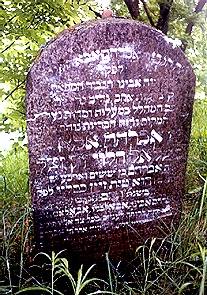 >>>>>
>>>>>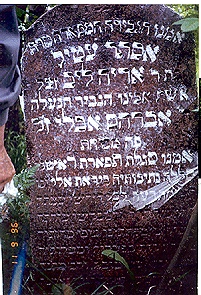
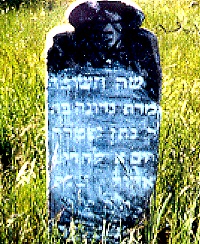 >>>>>
>>>>>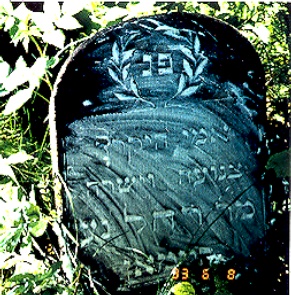
The Small Lithuanian Encyclopedia, Vilnius 1966-1971 (Lithuanian).
The Lithuanians Encyclopedia, Boston 1953-1965 (Lithuanian).
Lite, New-York 1951, Volume 1 (Yiddish).
Yahaduth Lita, (Hebrew) Tel-Aviv, Volumes 1-4
Gotlib, Ohalei Shem, page 363
Yad-Vashem Archives: M-33/979; 0-3/1890, 2582, 3548
Central Zionist Archives: 55/1788; 55/1701; 13/15/131; Z-4/2548.
HaMeilitz (St. Petersburg) (Hebrew): 5.12.1882, 7.5.1883, 10.8.1883, 27.11.1885, 21.10.1887, 6.6.1888
Cohen Berl,. Shtet, Shtetlach un Dorfishe Yishuvim in Lite biz 1918 (Towns, Small Towns and Rural Settlements in Lithuania till 1918) (Yiddish) New-York 1992.
Dos Vort, Kovno (Yiddish): 23.9.1935
Folksblat, Kovno (Yiddish): 7.8.1935
Unzer Veg (Our way) (Yiddish), Kovno, 2.7.1925
Kovner Tog (Day of Kovno) (Yiddish), 17.6.1926, 18.6.1926
Masines Zudynes Lietuvoje (Mass Murder in Lithuania) vol. 1-2, Vilnius 1941-1944 (Lithuanian).
Pinkas haKehiloth. Lita (Encyclopedia of Jewish Settlements in Lithuania) (Hebrew), Editor: Dov Levin, Assistant editor: Yosef Rosin, Yad Vashem. Jerusalem 1996.
The Book of Sorrow, (Hebrew, Yiddish, English, Lithuanian), Vilnius 1997.